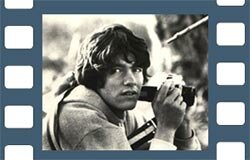|
ONLINE: ABOUT FILM AND VIDEO
 |
Cinematography. A powerpoint slide presentation that covers the basics of cinemagraphic lighting, composition, movement of camera, and the concept of editing. Best viewed using Internet Explorer. Source: Steve Newcomb DIVA Center (MID-HS). |
 |
Blast On BBC. Here's a chance to watch the Blast Masterclasses that were broadcast on BBC Two. There are tips from industry experts on how to write a drama, what makes a good documentary, shooting a music video and plenty more. Use these top tips to get creative with your own productions.Source: BBC (MID-HS). |
 |
Film Language. When we talk about reading a film what we actually mean is looking at the film in great detail to see how it is put together. There are many different elements to consider when undertaking such an activity and it is usual to read an extract from a film rather than the whole film. Site covers the topics of film codes and signals, use of camera, lighting, sound, editing. Source: Film Education UK (HS) |
 |
Five Steps to Get Creative. Need help with your creative projects as they develop from the initial idea right through to showcasing and beyond? Check out these tools and tips to help you get creative. Travelling from idea to reality is like a rollercoaster ride. Here you'll find ideas and inspiration to support you along the way. Source: BBC (HS) |
 |
Five Steps to Multimedia Reporting. This site offers a number of tutorials that will help students learn about choosing a story, doing fieldwork, editing, and even offer a few tips on shooting video. The site is divided into sections that provide tips on picking the right video camera for the assignment and those that give some useful information on the various audio recording devices that might come in handy. Source: Scout Report (HS) |
 |
How to write a Biography and Video Description. A bio is a statement about you that accompanies your film when entered into festivals. It gives people an idea of who you are, your training and experience, and other interests you have as an artist and just as a person. Your video descripton is usually the first thing people learn about your film, before they watch it. (HS) |
 |
iMovie Tutorial. Through the use of easy-to-follow movies, step-by-step instructions, and helpful tips, you’ll learn the basics of iMovie. Source: Apple (MID-HS) |
 |
iMovie 2. A free video tutorial series for iMovie 2. Even though iMovie 3 and 4 have been released, many people continue to use iMovie 2, either because they are running Mac OS 9, or because they have a personal preference for this version of the software. Source: Atomic Learning (MID-HS) |
 |
Making Movies - A Guide For Young Filmmakers, written by The Film Foundation in partnership with the Directors Guild of America, provides easy, fun, step by step lesson and activities for making a movie [each chapter available as PDF files ]. This guide is designed for teachers but is an excellent resource for individuals interested in learning more about filmmaking. |
 |
New Media - Free Courses Online. The BBC provides guides and modules that, in some cases is techical, there are many that provide basic operating procedures on basic media production for TV, Radio, and Broadcast Technology. Students will benefit from the sage advice contained within these various modules. |
 |
Shooting Back. Videomaker Årticle. For over 20 years, innovative and exciting video production programs across the country have challenged teenagers to pick up their camcorders and create their own video movies. Now teen videographers, with their own TV shows, video contests and distributors, are the hottest thing going. But you won't see any remakes of MTV here. These kids are a sophisticated bunch, using video to explore the issues of the day and tell their own stories as part of the growing trend of teen-made video. |
 |
Sound Recording. The science of sound, sound recording equipment, basic recording techniques, the relationship between sound and image. Best viewed using Internet Explorer. Source: Steve Newcomb DIVA Center (MID-HS). |
 |
UthTV: The Lab. This site provides informative articles about getting started with production, video lessons and other information about producing your own video. Uth TV is an outlet for the next generation of storytellers. |
 |
Video Guide: This is a resource for students to use as they explore the world of video. It provides links to advice sheets, activities, glossaries, and more. It is useful whether you're just getting started or have already been using a video camera for a while. |
 |
What is A Storyboard? Once a concept or script is written for a film or animation, the next step is to make a storyboard. A storyboard visually tells the story of an animation panel by panel, kind of like a comic book. This visual guide suggest ideas for making an effective storyboard. Source: Women and Technology. (HS) |
ONLINE: ABOUT PHOTOGRAPHY
Digital Kids Club. provides a number of online tutorials Introduction to digital photography. Source: Adobe (MID-HS)
Making Photographs. A tutorial by Philip Greenspun. Covers basic photography such as light, lens, film, explosure, and camera. Source: Photo.net (HS)
Photo Foolery. How to "read" photographs is the theme of this site that helps sharpen your looking at pictures and the world around you. Source: National Geographic. (MID) (HS)
Taking Great Pictures . Explores the many dimensions of photography. The site is full of "how to" tips and ideas. The site also includes a good section on using digital cameras. Source: Kodak (HS)
IN PRINT: BOOKS AND GUIDES
 |
Digital Filmmaking for Teens. Authors Pete Shaner and Gerald Everett Jones.You don’t have to invest a small fortune, own expensive gear, and employ an army of technicians to create a movie. Today’s high-tech tools will fit in your backpack and don’t require the financial backing of a major movie studio, making this the first generation in the history of moviemaking that doesn’t have to beg for big bucks to put its stories on the screen. “Digital Filmmaking for Teens” emphasizes Hollywood–style moviemaking, the way the pros do it. You’ll learn how to tell your story on a budget, using tips from industry veterans. Not sure where to start? No problem. You’ll cover each step—from developing your idea and writing a script to planning for production, shooting, and editing. “Digital Filmmaking for Teens” includes an amazing DVD packed with advice, instructional videos, and examples.
Source: Premier Press, Paperback, Bk&CD edition, Published December 2004, 237 pages, ISBN 1592006035. (HS)
|
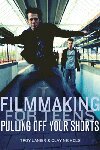 |
Filmmaking for Teens: Pulling Off Your Shorts. Authors Troy Lanier and Clay Nichols. Teens, more than any other demographic group, are being assaulted by a never ending stream of media junk food. This hip and irreverent basic guide book to the filmmaking craft empowers teens to stop consuming and start creating quality work with step-by-step instructions on writing, producing, directing, and distributing short film or video projects.Today, a teen with a camera and a vision; tomorrow, the next Speilberg?
Source:Michael Wiese Productions (April 25, 2005) 192 pages, 140 photos and original illustrations
ISBN: 1932907041 (HS)
|
 |
The Making Movies: A Guide for Young Filmmakers. A detailed production guide that takes you step-by-step through the filmmaking process from story concept to completed film. The manual includes tips from the experts, hands-on exercise, an 8-week filming schedule and more! Note you must fill-out a form that ask for name and e-mail address. Check with parent or teacher before downloading. Once registered you can then select the chapters from the manual that you wish to print. The documents require Adobe Acrobat. Source: The Film Foundation (HS) |
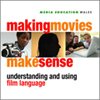 |
Making Movies Make Sense. A unique Mac/PC CD-ROM that will help children and young people to understand film language.The effect of camera, sound, light, colour and editing are clearly explained using dozens of specially shot stills, video and audio clips. How-to sections link theory and practice, and the 'Making a film' section describes how to go about planning, shooting and editing a film. |
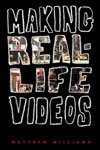 |
Making Real-Life Videos . In his new book Making Real-Life Videos, filmmaker and media educator Matthew Williams offers a complete overview of documentary filmmaking. Designed for people who have little or no experience using digital video, it can be used by children, teens, and adults. What is a documentary aside from its ability to document real people and events? "The raw footage usually captures reality," says Williams, "but once it is assembled or edited together with sound effects, narration, music, text, and other visual representation, it becomes manipulated into something else. That something else is called a documentary."
Beginning with a complete overview of documentary filmmaking, Williams teaches step-by-step instructions on how to create exciting personal documentaries including basic production concepts and processes.
Chapters cover: Planning and shooting a documentary - Writing treatments - Interviewing tips - Shooting voiceover - Storyboarding - Writing and shooting dramatizations - Editing and postproduction - Camera movement, angles, and operation - Working with audio. Allworth Press.
ISBN number is 1581154151. |
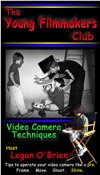 |
The Young Filmmakers Club: Video Camera Techniques." This 25 minute color video introduces the digital video camera and explains how to use it. Logan O'Brien instructs step-by-step camera selection, camera operation, framing and camera movement. An emphasis is placed on how the camera becomes part of the visual storytelling process.
The video was nominated for best video in the Film and Video, Non-Broadcast category at the New York 2002 International Film and Video Festival. Volume 2 in the series, "Digital Video Editing," is available now. Produced by Thomas Gertsch. See www.youngfilmmakersclub.com for more information! (HS)
|
|
|
Girl Director A How-To Guide for the First-Time, Flat-Broke Film and Video Maker. Chock-full of fascinating photographs and colorful directives, Andrea Richards's GIRL DIRECTOR is an instruction manual, history lesson, scrapbook, and celebration of women and film rolled into one. Director and cinephile Andrea Richards all but hands the reader a camera as she raucously paves the way for young women to make their own films. Sharing tales of the coolest femme filmmakers from history and recounting advice from the best women directors now in the business, Richards explains step by step how anyone can make a film using a standard video camera. Covering such topics as screenwriting, storyboards, set design, editing, distribution, Claymation, music videos, film festivals, and the digital revolution, GIRL DIRECTOR is a must-have handbook for the aspiring auteur of any age. Read More. |
MEDIA STUDY RESOURCES
|
|
My Pop Studio is a creative interactive experience that strengthens critical thinking skills about television, music, magazines and online media directed at girls. Users select from four behind-the-scenes opportunities to learn more about mass media. Included is the Magzine, TV, Music, and Digital Studio. This is a free online non-commercial site developed by teachers for teens. Although designed for girls others will enjoy exploring the site as well. |
|
Free Media Education Kit. "Media Education: A Kit for Teachers, Students, Parents and Professionals" has been published in English and French by UNESCO. The kit is partly a product of the MENTOR project initiated by UNESCO and supported by the European Commission. It proposes a prototype of media education curriculum for the basic qualification of secondary school teachers, but it also extends its modular approach and key concepts (production, language, representation, public) to adults outside the school system, be they parent, media professional or decision-maker. In addition to a teachers' manual and accompanying students' handbook, the kit also contains a manual for parents as well as a handbook on ethical relations with professionals and one on internet literacy. Download Kit.
|
Code: MID - Middle School, HS - High School
TOP
|

